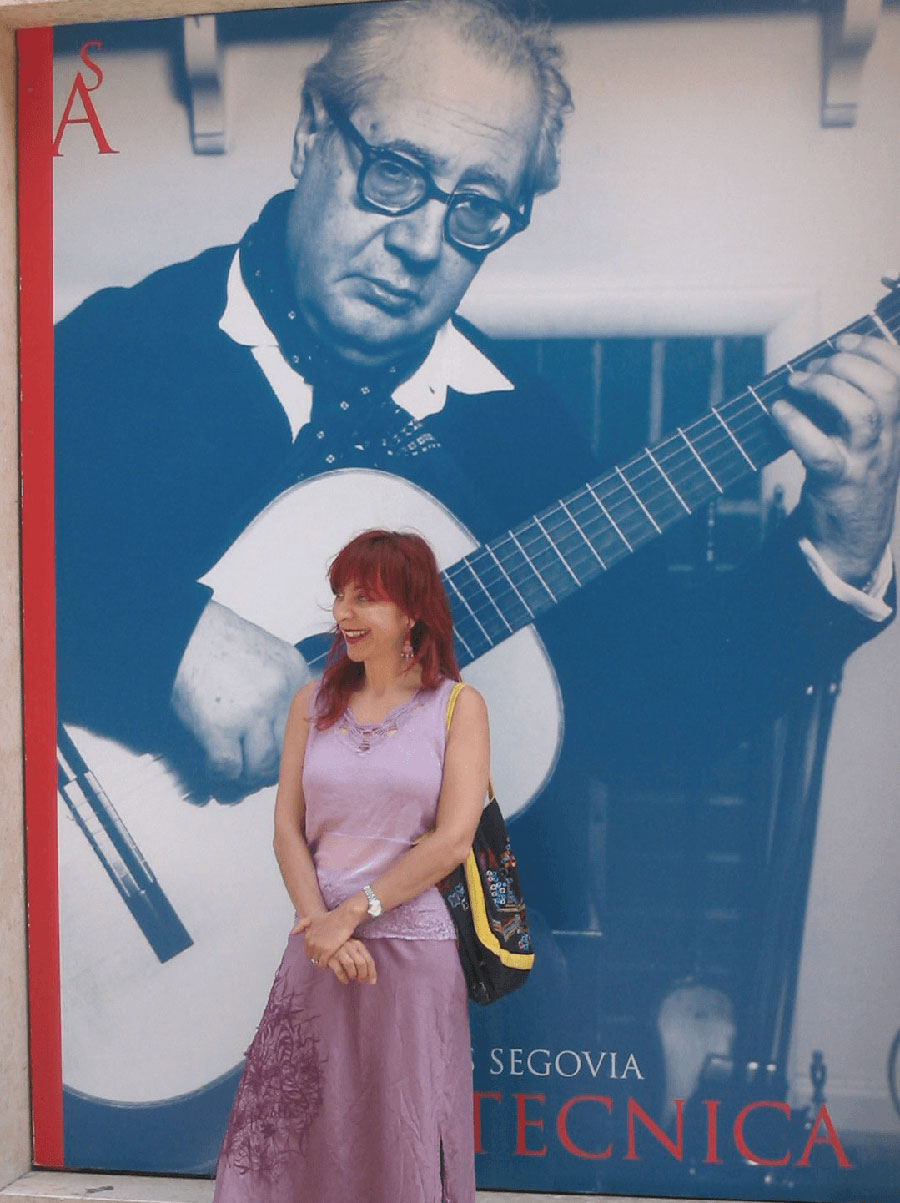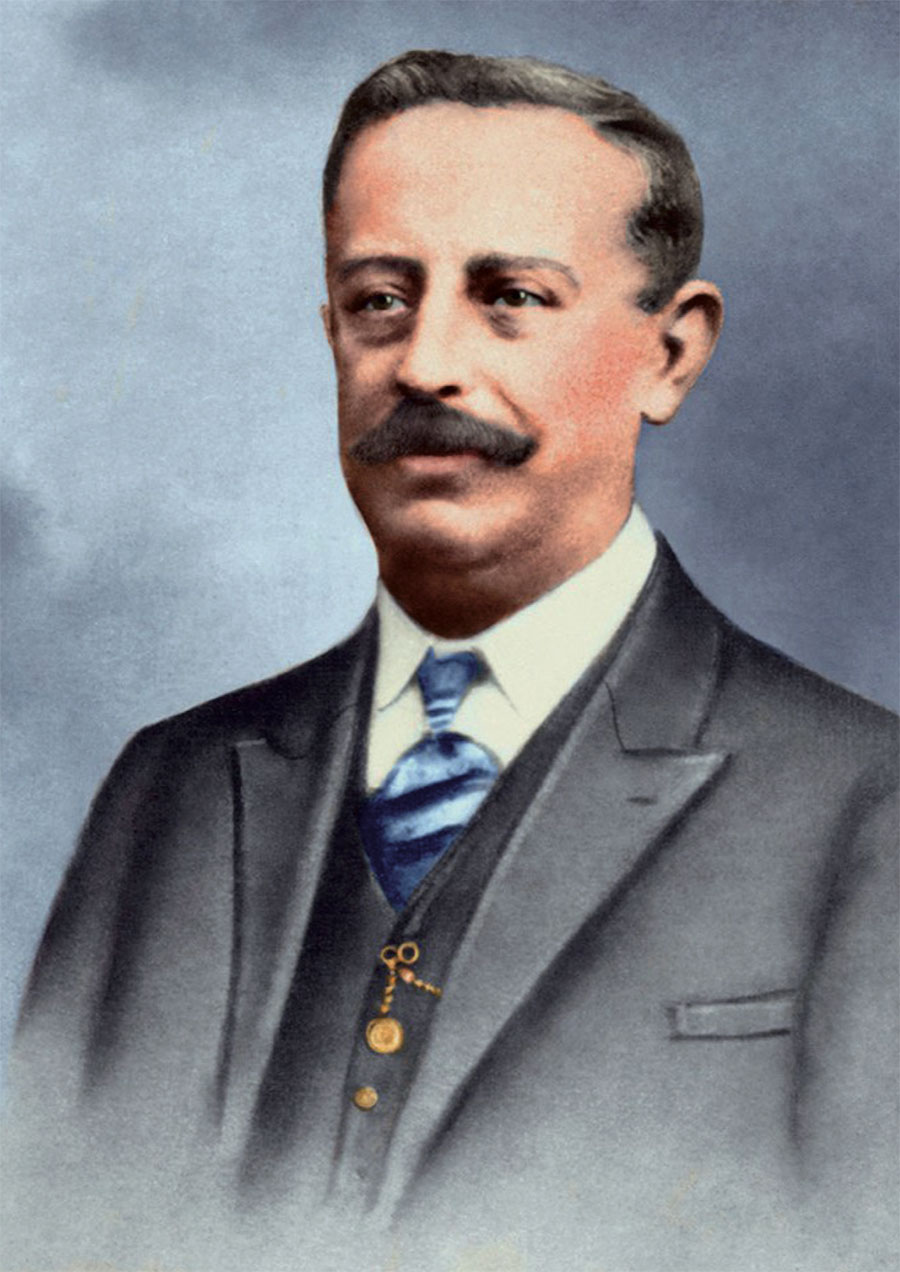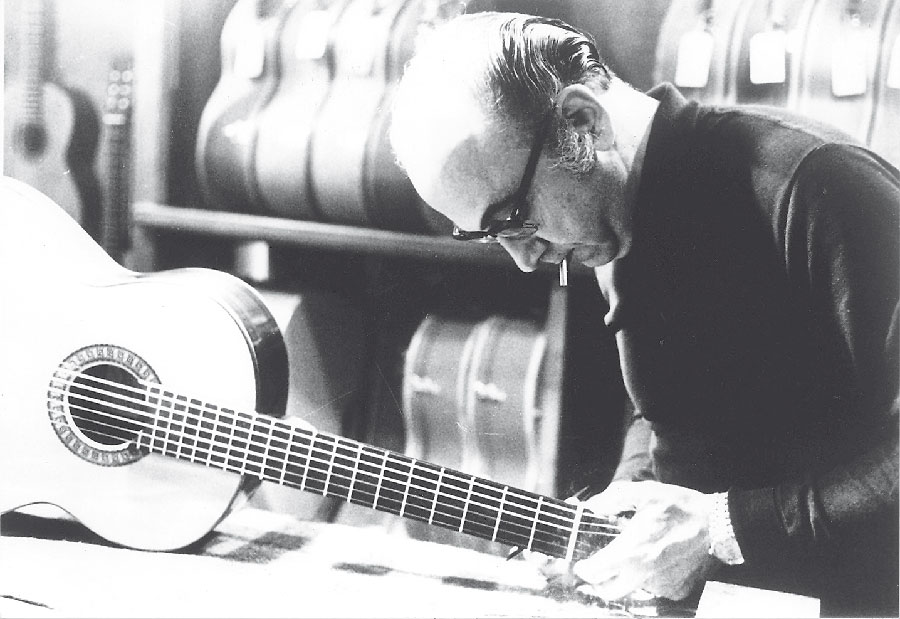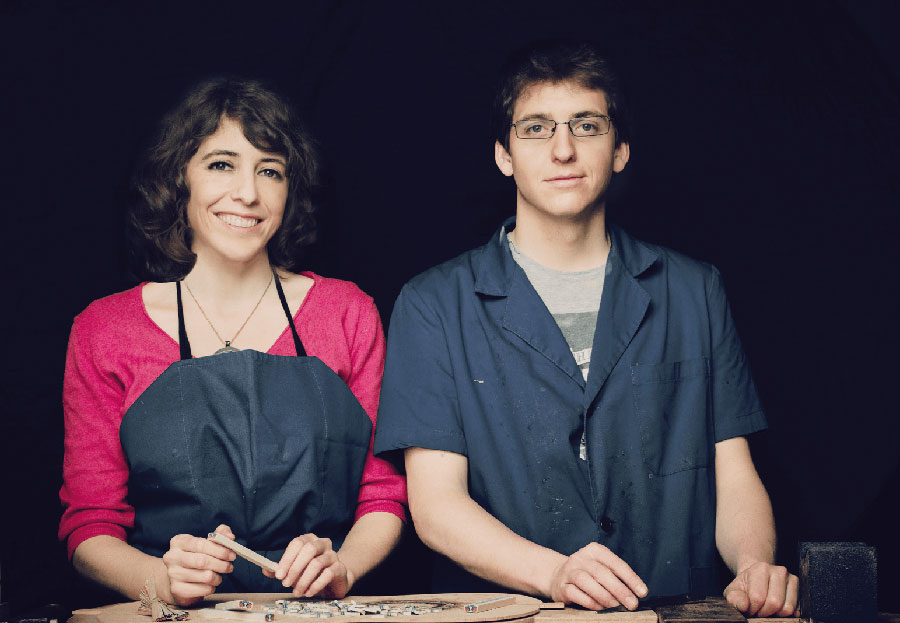The History of Ramírez Guitar Makers
José Ramírez de Galarreta Planet, was born in Madrid in 1858. At the age of 12, he began working as an apprentice in the workshop of Francisco González, who was later to become his Maestro. The Gonzales shop was located on the Carrera de San Jerónimo Street in Madrid.
In 1890 Jose I established himself at Concepción Jerónima nº 2, where his descendants continued to build guitars until the year 1995. Later, the store was relocated to La Paz nº 8, very near the old shop.
Although Francisco González had José Ramírez as his only pupil; José was teacher to his younger brother, Manuel Ramírez, as well as his son, José Ramírez II.
He also taught Enrique García, who later established himself in Barcelona, where he taught Francisco Simplicio, and Julián Gómez Ramírez. He also imparted the trade to Antonio Viudes, Rafael Casana, as well as to Alfonso Benito and Antonio Gómez. Thus, the Ramirez Dynasty began in José Ramírez’s workshop.
José Ramírez was recognized as an outstanding master guitar-maker. Flamenco guitarists would frequently approach him to find a solution for better projection of sound, which lead to José creating the “tablao guitar.”
Although he was in agreement with the design by Torres, he built a larger flamenco model than most classical guitars in those days. The tablao guitar brought him much success, and added to his reputation as a Master Luthier.
Manuel Ramírez de Galarreta y Planet was born in Alhama de Aragon in 1864. Although the habitual residence of the family was Madrid, the father’s profession forced them to reside some time in this town. Manuel learnt the guitar-maker’s trade, from his elder brother, José.
At the age of 27, in 1891, he decided to establish himself on his own. At the beginning, his idea was to move to Paris, and when he communicated his idea to José, he helped him to carry out his project.
However, for reasons unknown, Manuel changed his plans, and he finally established himself in the nº 24 Cava Baja Street of Madrid, which caused an enmity between the two brothers. The rift between them was, sadly, never resolved. After a time in Cava Baja Street, Manuel moved his shop to nº5 Santa Ana’s square, and later on to nº10 Arlabán Street, where he stayed indefinately.
In a short period of time he was to develop great prestige, by not only making guitars, but also violins, and he was named “Luthier of the Royal Conservatory of Madrid”. In addition, he continued the school begun by his brother, and the guitar-makers he mentored were recognized as amongst the best.
These pupils were Santos Hernández, Domingo Esteso and Modesto Borreguero.
With all the success obtained by the tablao guitar designed by his brother José, it was natural that Manuel continued building it, but little by little he started developing it and perfecting it, culminating in an instrument that, still today, is the “model” for this type of guitar. Around 1912, a young man presented himself in the workshop in Arlabán Street with the purpose of renting a guitar for a concert he was to give. The clothes and general appearance of Andrés Segovia were outlandish. The strangeness of the petition, as well as the visitor’s aspect, made Manuel play with the situation giving him a guitar but not taking him very seriously.
However, after listening the youth playing, Manuel was so amazed that he decided to give him the guitar. That prodigious guitarist who played in taverns in exchange for a coffee was Andrés Segovia. The guitar that Manuel gave him is now on display in the Metropolitan Museum of New York.
José Simón Ramírez de Galarreta y Pernias was born in the year 1885. He grew up in his father’s shop, where he not only learned the trade from his father, but from journeymen like his uncle Manuel, Enrique García, and Julián Gómez. Besides being a guitar-maker, he was a guitarist, and when he was 20 years old, he was hired to go on a two-year tour of South America.
He found it very difficult to convince his father to let him accept the contract, but finally he convinced him that two years was not such a long time. However, the tour was prolonged, and the two years turned into almost 20 years, when the group he traveled with had been dissolved. José stayed on in Buenos Aires where he met the girl who later would become his wife, and who had traveled from Spain to Argentina with her family. José and his wife had two children, José and Alfredo.
In 1923, he received the news of his father’s death and returned to Madrid with his family. Two years later he was in charge of the Ramirez workshop on Concepcion Jerónima. He was on the first floor of the store and was assisted by Jesus Martínez, as well as Alfonso Benito and Antonio Gómez, as journeymen and Marcelo Barbero, who was still an apprentice at the time. Manuel Rodríguez nicknamed ” Marequi” was there applying varnish but not as guitar-maker. His son, Manuel Rodríguez, would later become a guitar-builders apprentice.José Ramírez II was a Maestro recognized for his work and in 1923 he participated in the Ibero-American Exhibition of Seville, where he was awarded the Gold Medal. In 1936, due to the many problems that were brought on by the Spanish civil war, he had great difficulty in getting wood and materials for the construction of guitars. This situation lasted a long time, which hindered his work considerably. These shortages were often a topic of discussion with his son, José when he became a journeyman and began to do his own experiments.
José Ramírez Martínez was born in May 1922. He joined the family workshop in 1940, at the age of 18. His apprenticeship was completed with no privileges but very soon he was admitted as a journeyman and he quickly began to experiment, developing the guitar as a concert instrument.
Because of the lack of material, and the fact that his investigations were not very profitable, his father and he would constantly argue about his father selling his experiments without keeping track of his work. In 1954 his brother Alfredo died. He was in charge of the administrative work and was Jose’s best supporter, for he was convinced that Jose’s experiments would achieve their objective.
Three years later his father died and José took over the running of the business with the help of his wife, Angelita. He had to give up his bench in the workshop and devote himself to full-time management and supervision of his journeymen. He would work out his designs on paper and assign his journeymen to carry out the experiments he devised. Many of his investigations bore interesting fruit; like the discovery of red cedar for the harmonic top in 1965. This discovery was later adopted by, practically all guitar manufacturers in the world, although, at the beginning it was highly criticized because of its innovative nature.
He also tried different varnishes, and since his guitars were lacquered with alcohol based shellac like furniture, he felt they needed a more consistent rich varnish that not only protected the wood but also would produce a better sound. Finally he persuaded the owner of a laboratory, which sympathized with his restless pursuit, to mix an elaborate urea based varnish that gave an excellent result.
We used this urea-based varnish for many years but regrettably, some years ago, the laboratory changed their formula, which affected the quality, and we had to stop using it. José Ramírez III made several experiments with the string length, arriving at a particular scale that gave the best result for sound and projection without being too long. This 664 mm scale is the one being used today, but there was also a demand for a shorter scale, which persuaded him to design a guitar with a 650mm scale. This happened in 1986, and for that reason the model was named C86, referring to the year of its creation. Later on his son José Enrique modified the design, keeping the 650mm scale but changing the name of the pattern.
In 1983, Jose designed the “Camara” guitar, with the intention of eliminating the “wolf notes.” It gave some positive results, for instance, the clarity of its sound was excellent for studio recordings. This model adds an interior finish of Jacaranda or Caviuna located near the middle of the sides. The new guitar models were built with double sides of cypress in the interior. Later, sycamore was used and later still, half double internal sides were added. These design features remained until 1991. The double sides of cypress are glued to the Rosewood. Because Jacaranda, Caviuna and Cypress are all solid woods, the notion that this was a plywood construction is incorrect. It was one of José’s Ramírez III acoustic experiments, and because of its excellent results, we still it use it today in our traditional guitars. In fact, some other guitar makers are using our technique as well. One of José’s designs, which deserve acknowledgment, is the 10-string guitar.
He started by performing some tests based on the “viola d’amore”, but did not get satisfactory results. This prompted him to consult with Narciso Yepes, who was very helpful in the development of this instrument.
Later he designed the eight-string guitar for José Tomás. Meanwhile, José’s main collaborator was Andrés Segovia. Ever since they met in 1952, Segovia was the one pointing the way with his wise critique. His demands and his scant approval reigned supreme in Jose’s ears, for Maestro Segovia was extremely demanding when he had to choose an instrument for his own use. This provided a great stimulus for Jose in knowing that Segovia should be interested in one of his guitars. In 1960 he built a guitar in which he compiled all the experiments that had given him good results. He added new ideas like the thickness of the wood, and asymmetries in the internal structure as well as vibrant masses at the traverse bar. When Segovia tried that guitar, the said he would like to keep it for a season, so he took it with him for a while and traveled with it, during his tour of Australia Tour in 1961. That was the first of a long list of guitars built by José Ramírez III for the Maestro to perform with in his concerts. As his construction techniques improved, he continued to experiment.
Those days coincided with the beginning of a long period of expansion, and this helped propel the guitars to worldwide popularity. José moved the workshop to General Margallo Street, while maintaining the small store at Concepción Jerónima 2.
In the new workshop, he teamed-up with several guitar-makers to be able to take care of the growing demand for his instruments. Later, toward 1970-71, he moved the workshop to a larger building, accepting even more journeymen, as the waiting list for his guitars had increased by two years. However, the workshop never became a factory. There were dedicated for coarse work while the artisans did the delicate work. He ended up having a great number of journeymen building each guitar, from the beginning to the end, in accordance with the traditional method.
There was never any “mass production”. However, several apprentices were trained and assisted helping the journeymen in their tasks. They would loosen screws; untie borders, sand, and other jobs that allowed more time for the journeymen to do their delicate work. Also in 1971, the store in Concepción Jerónima Nº2 was relocated to a larger one, directly opposite the old one at number 5, on the same street. Many honors and awards were bestowed on him, among the most outstanding, were the gold medal of the Guitar Society in Chicago in 1962, the Bronze medal award by the Official Chamber of Commerce and Industry of Madrid, and the Gold Medal to the exemplary Artisan of the Union Work of Craft, in Madrid, in 1972. He was also elected Honorary Partner of the Centre Culturale de la Chitarra in Rome in 1968, and Honorary Partner of Music in Compostela in 1983. He also obtained the DIAPASON D’Or from the Ministry of Education and Culture of France in the year 1987.
Among all of the many cherished awards, he held most dear, a letter dedicated by Andrés Segovia honoring his work.
José Enrique Ramírez García was born in Madrid during May 1953. He started working as an apprentice in 1971 and reached the category of journeymen in 1977. In 1988, he decided to run the family business with his sister Amalia. His idea was to re-define the models that were being built then. In the middle of the 80’s, a change had been detected in the taste in sound of some guitarists.
In 1979, he got the recognition of Andrés Segovia, since the Maestro chose, from among several guitars that the workshop had previously selected and had sent to him. The one constructed by José Enrique was the one chosen. This was a big surprise and especially a big satisfaction for him. His joy was so great that he wrote a great dedication with signature that was stuck beside the label. Mr. Segovia used this guitar until the end of his days, and according to the letters written by Segovia to José Enrique, he used it with great satisfaction.
In 1991 he began building a guitar with all the characteristic sound of the sixties, which he named Traditional, and another one, which didn’t have anything to do with the previous one, one which expressed that clear and direct sound which was the solution for new tendencies. That guitar, after several experiments, was completely defined in 1992, and he denominated it as the Special.
Today, two lines are built in Ramirez’s workshop. Essentially, José Ramírez IV defined and improved the work done by his father, although he also introduced his own innovations. Besides defining the two lines of professional classic guitars, he developed techniques of construction that made them the most comfortable and easy instruments to play, and also more stable in their assembly, thus avoiding in some cases, and reducing in others, the deformations due to the movement of the wood.
Another important chapter is the addition of the student guitars. This never attracted José Ramírez´s III whose interest was centered exclusively, in the professional guitars. In fact, already in the time of José Ramírez I, those guitars, dedicated to beginners, students and people with less purchasing power, were sold in the workshop as an alternative to those made by hand that, which naturally, were much more expensive and of a very superior quality. That is still the case today.
José Ramírez I, who had rejected guitars “made in series”, had also seen the necessity of selling them in his business. At the beginning he didn’t put a label on them, but with time he realised that this was a mistake because people would come to his shop with complaints and he couldn’t prove the guitar was really made in his workshop. So, finally, he ordered some special labels, different to those of the professional models and resolved the problem.
José Ramírez II kept selling student guitars made in series, and more than that, he also designed some student models and ordered them from the best manufacturer in Valencia. One of those models remained in the workshop until the middle of the 1970s. By then, and for many years since, student models were sold, which were not designed by Ramírez. These were chosen from among the normal production of selected factories, based on the most acceptable quality. José Ramírez III, like his grandfather, rejected the student guitars, which is why he didn’t care about the eventual disappearance of those guitars designed by his father. However, José Ramírez IV didn’t think this way.
He was very aware of the importance that those guitars could have for beginners. Offering the student guitar would bring a guarantee of quality supported by the Ramírez name. His argument was that a beginner shouldn’t necessarily start playing with a professional guitar, and that it was necessary to offer an instrument that, besides being accessible in price, should have good quality and be pleasant to play with. This “Relationship Marketing” undoubtedly, leads to sales of the professional models to some of the beginners, who have become used to, and trusted the Ramírez brand.
This vision, prompted him to, during 1986, design a student line, manufactured exclusively for Ramírez, with a special selection of wood and strict construction standards. This line was welcomed in the market, as a good starting point toward professional use. Later, coinciding with changes in the professional models, José Enrique designed another, more economic, student line than the previous one, denominated ” R “, being based on the insole of the professional pattern C86.
A native of Madrid, Amalia began her guitar making apprenticeship in the workshop under the direction of her father in 1976. She left for a few years, only to return to help her brother Jose Ramírez IV, in the restructuring and management of the shop, and to bring a new look to the family business.
The work was evenly distributed between the two. José Enrique was devoted mainly to the workshop while Amalia applied herself to the commercial aspects. Amalia also built guitars after establishing the workshop again in General Margallo.
The real change occurred at the beginning of 1993 when they returned to the original outline of a reduced workshop and a limited production. “Today, all of our professional guitars are sold. They can be acquired in our store in Madrid or through our world-wide network of distributors.” In the summer of 1995 the store moved from Concepción Jerónima nº2, to the street of La Paz nº 8, very near the old store.
After the death of her brother in June 2000, Amalia Ramírez took over the direction of the business, dividing her time between the workshop, the office and the shop. She also inspects the guitars made in the workshop, both during and at the end of the construction process.
An important responsibility for Amalia, is the development and supervision of the apprenticeship of her late brother’s children, Cristina and José Enrique, who are both very proud of learning to make guitars and to run the family business.
José Enrique, has combined his apprenticeship as Luthier with his career in Law, and Cristina, is applying her training and experience as Graphic Designer, Journalist, and Sound Technician in the interest of the family business. With this and Amalia’s mentorship, they will continue the Ramírez dynasty of guitar makers, ensuring that the quality and value of the legendary Ramírez Sound will continue.
Since taking over the direction of the business, Amalia has employed an investigative approach to guitar making, which began with different analyses of the template and fan bracing of the guitars, some based on the golden section, a route along which she has only recently begun to travel. The work is slow, not only because each investigation necessitates a huge investment in terms of time, but also because she has to combine it with the running of all the other aspects of the business. She has designed a number of different models, including the SP, which is an intermediate guitar between the student and the professional models as well as two different models to celebrate the 125th anniversary of the foundation of the Ramírez firm. The first is the Anniversary guitar, a Limited Edition Professional guitar, of which only125 will be made, and a student model, The 125 Years Guitar, which were produced for a Limited Period of five years, between January 2007 and December 2011
A long time ago a guitar maker asked Cristina “How did your father manage to get you two to continue with the tradition? My son didn’t want to, preferring to follow another path.” The reply could only be by offering freedom of choice. José Ramírez IV never pressurised his four children to continue his profession. On the contrary he encouraged them to learn and to study other disciplines. He wanted them to choose from a position of knowledge, from the heart and through freedom. As a result, although only two of them are following in his footsteps, his children Cristina, Almudena, José Enrique and Javier admire and deeply respect his work. Only Javier, who started in the workshop with his twin brother José Enrique, subsequently decided to take another path and follow the family tradition of the maternal side – the pharmaceutical profession. Almudena, a psychologist by profession still has to finish her first guitar.
José Enrique and Cristina felt the calling of this tradition since they were very young. The love of music and the guitar, which was breathed in throughout family get-togethers, was a breeding ground culminating in their life choice. José Enrique combined his apprenticeship as a guitar maker with his law degree and Cristina is a graphic designer, journalist, sound technician and is studying the guitar at the Conservatory with Ana Jenaro. Currently she is learning the techniques of guitar making from her brother. Both run different areas of the business, José Enrique is head of the workshop and carries out new investigations and experiments while Cristina runs the commercial side and project development. New models of guitar are the fruit of teamwork between Amalia, Cristina and José Enrique.
At the moment they are focussed on two areas, one continuing with Amalia Ramírez’s research with the ‘Auditorio’ model to achieve greater projection without losing the quality of sound characterised in these guitars and the other looking to the past in the instruments of their great-great-grandfather José Ramírez I and and great-great-grand-uncle Manuel Ramírez, rediscovering the old techniques of construction such as natural glues and varnishes.
Ramírez Guitars´ objective is to listen to its guitarists and through them evolve and develop the guitar. Listening is the fundamental element of this profession and thanks to this, Ramírez Guitars has celebrated more than 137 years of history and intends to continue researching and creating new models for new times and new music.







